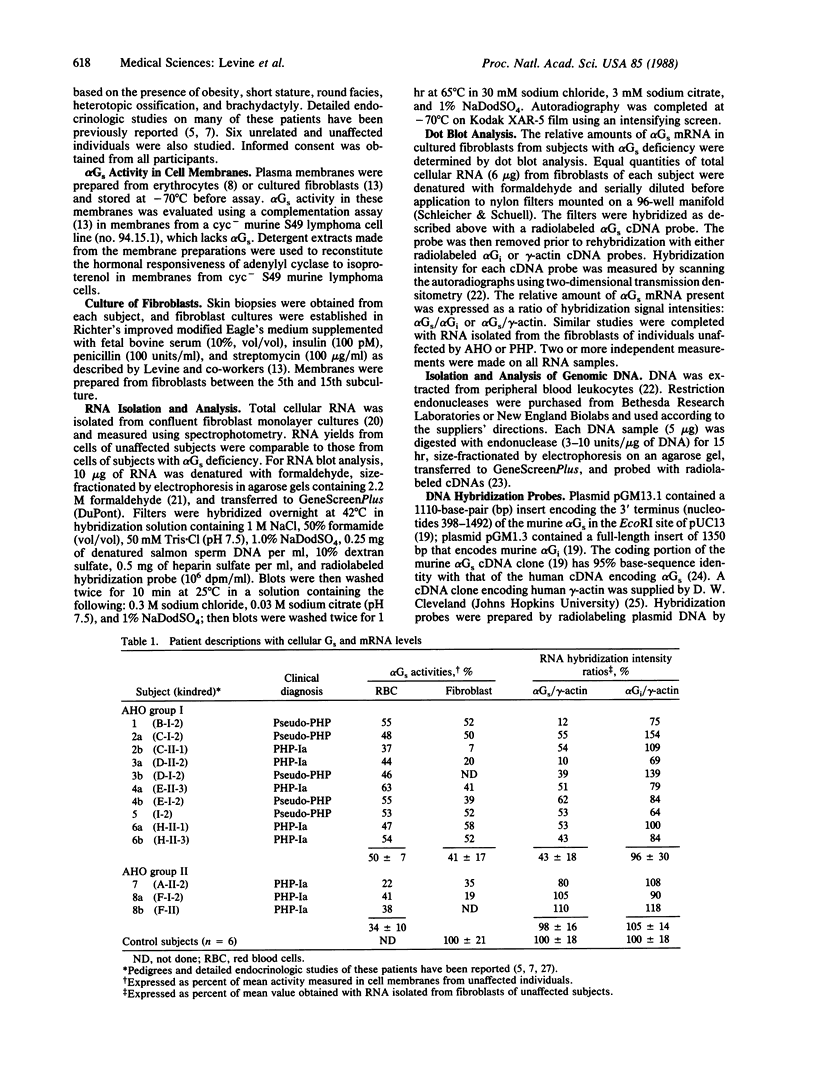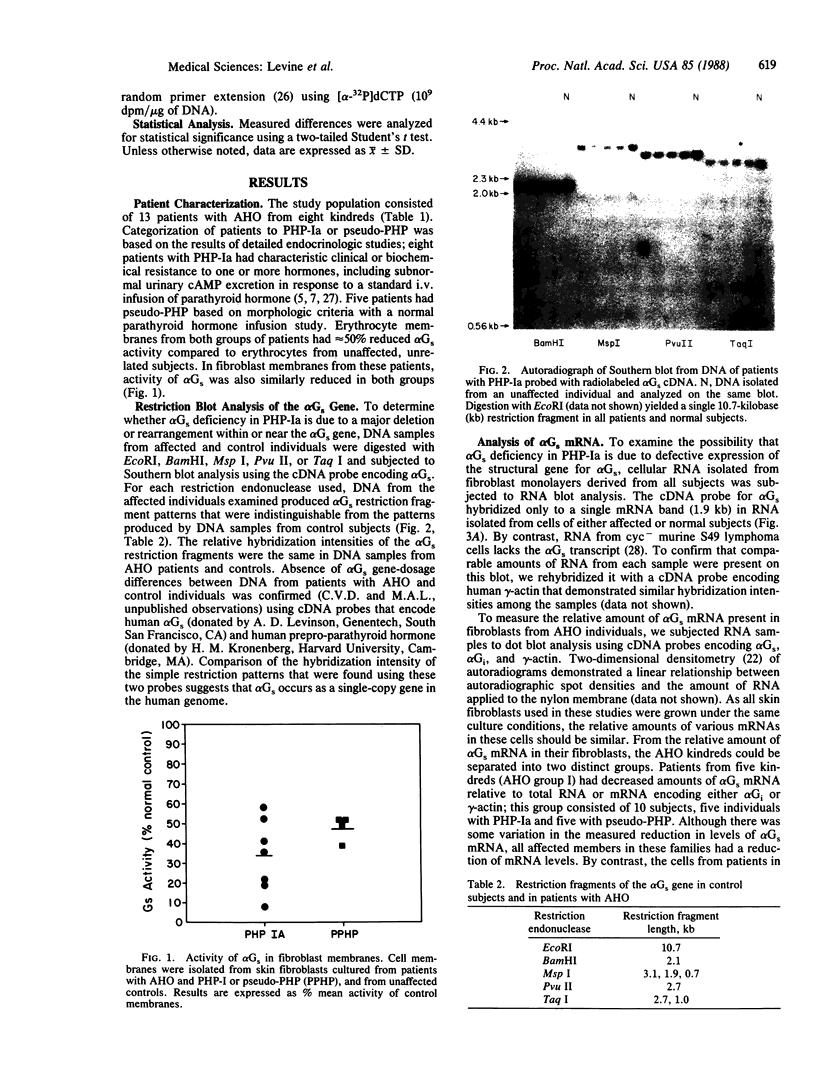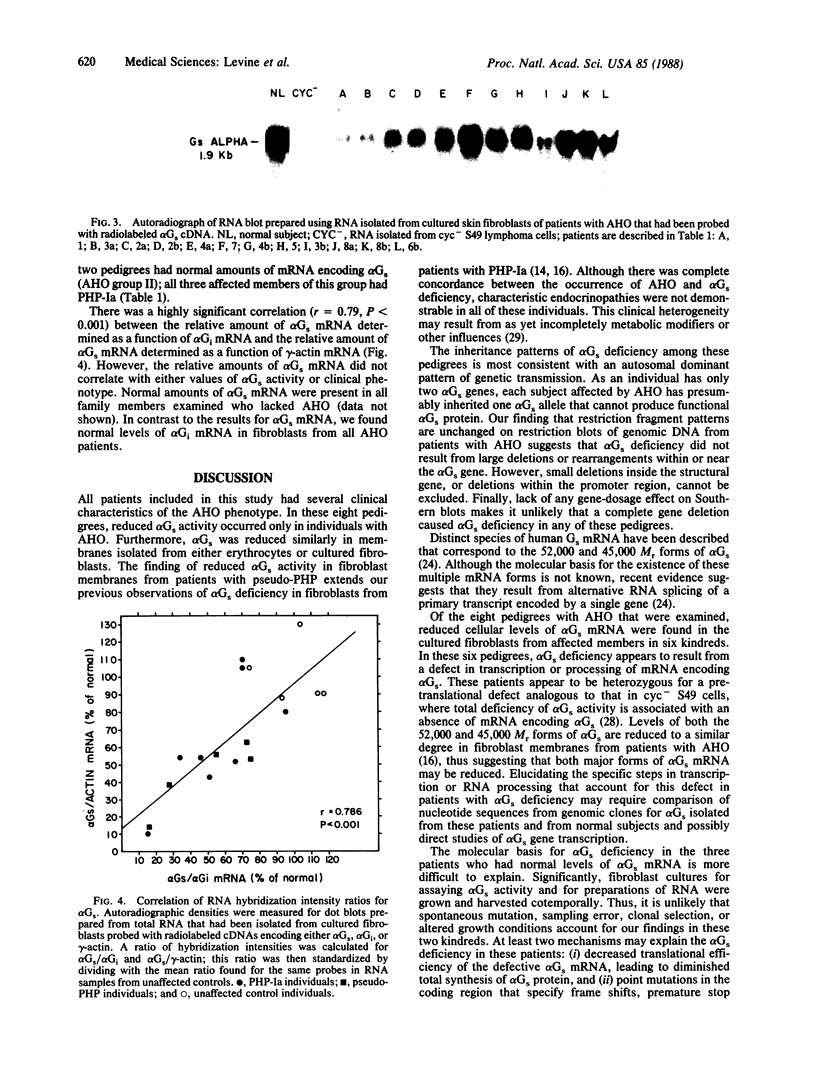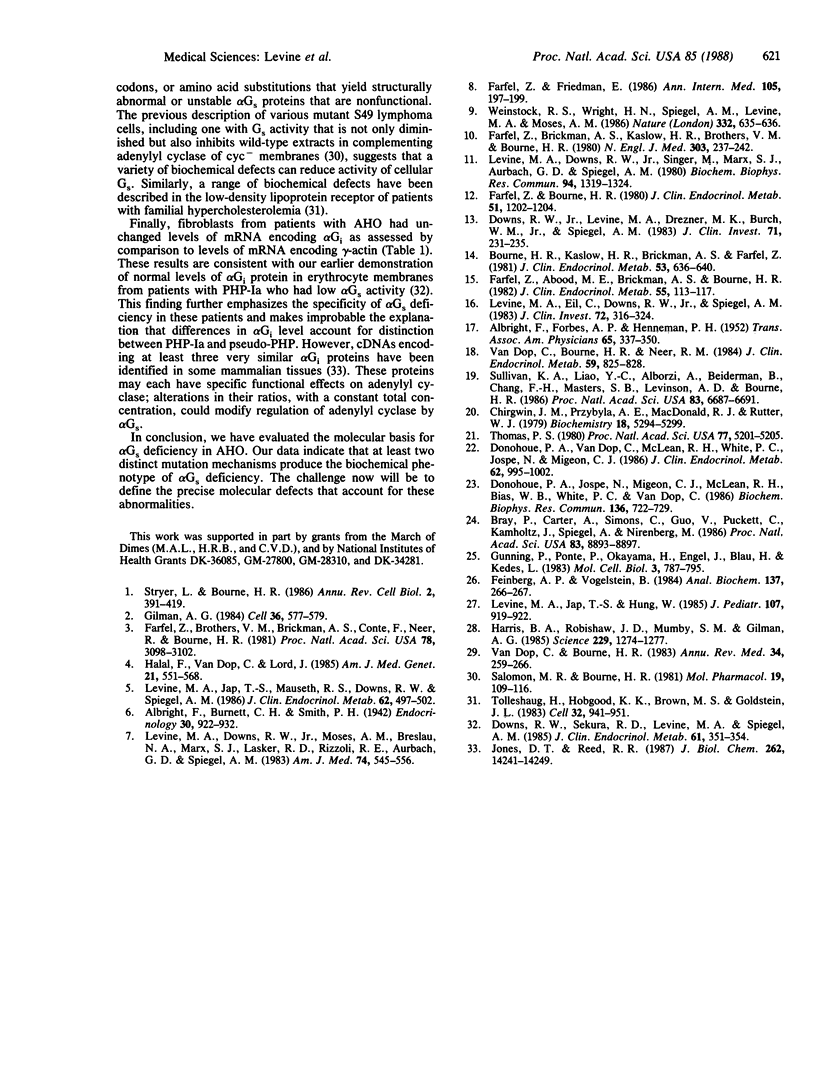Abstract
Patients who have pseudohypoparathyroidism type I associated with Albright hereditary osteodystrophy commonly have a genetic deficiency of the alpha subunit of the G protein that stimulates adenylyl cyclase (alpha Gs) (ATP pyrophosphate-lyase, EC 4.6.1.1). To discover the molecular mechanism that causes alpha Gs deficiency in these patients, we examined eight kindreds with one or more members affected with Albright hereditary osteodystrophy or pseudohypoparathyroidism and alpha Gs deficiency. In these families, alpha Gs deficiency and the Albright hereditary osteodystrophy phenotype were transmitted together in a dominant inheritance pattern. Using a cDNA hybridization probe for alpha Gs, restriction analysis with several endonucleases showed no abnormalities of restriction fragments or gene dosage. RNA blot and dot blot analysis of total RNA from cultured fibroblasts obtained from the patients revealed approximately equal to 50% reduced mRNA levels for alpha Gs in affected members of six of the pedigrees but normal levels in affected members of the two other pedigrees, compared to mRNA levels in fibroblasts from unaffected individuals. By contrast, mRNA levels encoding the alpha subunit of the G protein that inhibits adenylyl cyclase were not altered. Our findings suggest that several molecular mechanisms produce alpha Gs deficiency in patients with pseudohypoparathyroidism type Ia and that major gene rearrangements or deletions are not a common cause for alpha Gs deficiency in pseudohypoparathyroidism type I.
Full text
PDF




Images in this article
Selected References
These references are in PubMed. This may not be the complete list of references from this article.
- ALBRIGHT F., FORBES A. P., HENNEMAN P. H. Pseudo-pseudohypoparathyroidism. Trans Assoc Am Physicians. 1952;65:337–350. [PubMed] [Google Scholar]
- Bourne H. R., Kaslow H. R., Brickman A. S., Farfel Z. Fibroblast defect in pseudohypoparathyroidism, type I: reduced activity of receptor-cyclase coupling protein. J Clin Endocrinol Metab. 1981 Sep;53(3):636–640. doi: 10.1210/jcem-53-3-636. [DOI] [PubMed] [Google Scholar]
- Bray P., Carter A., Simons C., Guo V., Puckett C., Kamholz J., Spiegel A., Nirenberg M. Human cDNA clones for four species of G alpha s signal transduction protein. Proc Natl Acad Sci U S A. 1986 Dec;83(23):8893–8897. doi: 10.1073/pnas.83.23.8893. [DOI] [PMC free article] [PubMed] [Google Scholar]
- Chirgwin J. M., Przybyla A. E., MacDonald R. J., Rutter W. J. Isolation of biologically active ribonucleic acid from sources enriched in ribonuclease. Biochemistry. 1979 Nov 27;18(24):5294–5299. doi: 10.1021/bi00591a005. [DOI] [PubMed] [Google Scholar]
- Donohoue P. A., Jospe N., Migeon C. J., McLean R. H., Bias W. B., White P. C., Van Dop C. Restriction maps and restriction fragment length polymorphisms of the human 21-hydroxylase genes. Biochem Biophys Res Commun. 1986 Apr 29;136(2):722–729. doi: 10.1016/0006-291x(86)90499-7. [DOI] [PubMed] [Google Scholar]
- Donohoue P. A., van Dop C., McLean R. H., White P. C., Jospe N., Migeon C. J. Gene conversion in salt-losing congenital adrenal hyperplasia with absent complement C4B protein. J Clin Endocrinol Metab. 1986 May;62(5):995–1002. doi: 10.1210/jcem-62-5-995. [DOI] [PubMed] [Google Scholar]
- Downs R. W., Jr, Levine M. A., Drezner M. K., Burch W. M., Jr, Spiegel A. M. Deficient adenylate cyclase regulatory protein in renal membranes from a patient with pseudohypoparathyroidism. J Clin Invest. 1983 Feb;71(2):231–235. doi: 10.1172/JCI110763. [DOI] [PMC free article] [PubMed] [Google Scholar]
- Downs R. W., Sekura R. D., Levine M. A., Spiegel A. M. The inhibitory adenylate cyclase coupling protein in pseudohypoparathyroidism. J Clin Endocrinol Metab. 1985 Aug;61(2):351–354. doi: 10.1210/jcem-61-2-351. [DOI] [PubMed] [Google Scholar]
- Farfel Z., Abood M. E., Brickman A. S., Bourne H. R. Deficient activity of receptor-cyclase coupling protein is transformed lymphoblasts of patients with pseudohypoparathyroidism, type I. J Clin Endocrinol Metab. 1982 Jul;55(1):113–117. doi: 10.1210/jcem-55-1-113. [DOI] [PubMed] [Google Scholar]
- Farfel Z., Bourne H. R. Deficient activity of receptor-cyclase coupling protein in platelets of patients with pseudohypoparathyroidism. J Clin Endocrinol Metab. 1980 Nov;51(5):1202–1204. doi: 10.1210/jcem-51-5-1202. [DOI] [PubMed] [Google Scholar]
- Farfel Z., Brickman A. S., Kaslow H. R., Brothers V. M., Bourne H. R. Defect of receptor-cyclase coupling protein in psudohypoparathyroidism. N Engl J Med. 1980 Jul 31;303(5):237–242. doi: 10.1056/NEJM198007313030501. [DOI] [PubMed] [Google Scholar]
- Farfel Z., Brothers V. M., Brickman A. S., Conte F., Neer R., Bourne H. R. Pseudohypoparathyroidism: inheritance of deficient receptor-cyclase coupling activity. Proc Natl Acad Sci U S A. 1981 May;78(5):3098–3102. doi: 10.1073/pnas.78.5.3098. [DOI] [PMC free article] [PubMed] [Google Scholar]
- Farfel Z., Friedman E. Mental deficiency in pseudohypoparathyroidism type I is associated with Ns-protein deficiency. Ann Intern Med. 1986 Aug;105(2):197–199. doi: 10.7326/0003-4819-105-2-197. [DOI] [PubMed] [Google Scholar]
- Feinberg A. P., Vogelstein B. "A technique for radiolabeling DNA restriction endonuclease fragments to high specific activity". Addendum. Anal Biochem. 1984 Feb;137(1):266–267. doi: 10.1016/0003-2697(84)90381-6. [DOI] [PubMed] [Google Scholar]
- Gilman A. G. G proteins and dual control of adenylate cyclase. Cell. 1984 Mar;36(3):577–579. doi: 10.1016/0092-8674(84)90336-2. [DOI] [PubMed] [Google Scholar]
- Gunning P., Ponte P., Okayama H., Engel J., Blau H., Kedes L. Isolation and characterization of full-length cDNA clones for human alpha-, beta-, and gamma-actin mRNAs: skeletal but not cytoplasmic actins have an amino-terminal cysteine that is subsequently removed. Mol Cell Biol. 1983 May;3(5):787–795. doi: 10.1128/mcb.3.5.787. [DOI] [PMC free article] [PubMed] [Google Scholar]
- Halal F., Van Dop C., Lord J. Differential diagnosis in young women with oligomenorrhea and the pseudo-pseudohypoparathyroidism variant of Albright's hereditary osteodystrophy. Am J Med Genet. 1985 Jul;21(3):551–568. doi: 10.1002/ajmg.1320210317. [DOI] [PubMed] [Google Scholar]
- Harris B. A., Robishaw J. D., Mumby S. M., Gilman A. G. Molecular cloning of complementary DNA for the alpha subunit of the G protein that stimulates adenylate cyclase. Science. 1985 Sep 20;229(4719):1274–1277. doi: 10.1126/science.3839937. [DOI] [PubMed] [Google Scholar]
- Jones D. T., Reed R. R. Molecular cloning of five GTP-binding protein cDNA species from rat olfactory neuroepithelium. J Biol Chem. 1987 Oct 15;262(29):14241–14249. [PubMed] [Google Scholar]
- Levine M. A., Downs R. W., Jr, Moses A. M., Breslau N. A., Marx S. J., Lasker R. D., Rizzoli R. E., Aurbach G. D., Spiegel A. M. Resistance to multiple hormones in patients with pseudohypoparathyroidism. Association with deficient activity of guanine nucleotide regulatory protein. Am J Med. 1983 Apr;74(4):545–556. doi: 10.1016/0002-9343(83)91008-2. [DOI] [PubMed] [Google Scholar]
- Levine M. A., Downs R. W., Jr, Singer M., Marx S. J., Aurbach G. D., Spiegel A. M. Deficient activity of guanine nucleotide regulatory protein in erythrocytes from patients with pseudohypoparathyroidism. Biochem Biophys Res Commun. 1980 Jun 30;94(4):1319–1324. doi: 10.1016/0006-291x(80)90563-x. [DOI] [PubMed] [Google Scholar]
- Levine M. A., Eil C., Downs R. W., Jr, Spiegel A. M. Deficient guanine nucleotide regulatory unit activity in cultured fibroblast membranes from patients with pseudohypoparathyroidism type I. a cause of impaired synthesis of 3',5'-cyclic AMP by intact and broken cells. J Clin Invest. 1983 Jul;72(1):316–324. doi: 10.1172/JCI110971. [DOI] [PMC free article] [PubMed] [Google Scholar]
- Levine M. A., Jap T. S., Hung W. Infantile hypothyroidism in two sibs: an unusual presentation of pseudohypoparathyroidism type Ia. J Pediatr. 1985 Dec;107(6):919–922. doi: 10.1016/s0022-3476(85)80189-x. [DOI] [PubMed] [Google Scholar]
- Levine M. A., Jap T. S., Mauseth R. S., Downs R. W., Spiegel A. M. Activity of the stimulatory guanine nucleotide-binding protein is reduced in erythrocytes from patients with pseudohypoparathyroidism and pseudopseudohypoparathyroidism: biochemical, endocrine, and genetic analysis of Albright's hereditary osteodystrophy in six kindreds. J Clin Endocrinol Metab. 1986 Mar;62(3):497–502. doi: 10.1210/jcem-62-3-497. [DOI] [PubMed] [Google Scholar]
- Salomon M. R., Bourne H. R. Novel S49 lymphoma variants with aberrant cyclic AMP metabolism. Mol Pharmacol. 1981 Jan;19(1):109–116. [PubMed] [Google Scholar]
- Stryer L., Bourne H. R. G proteins: a family of signal transducers. Annu Rev Cell Biol. 1986;2:391–419. doi: 10.1146/annurev.cb.02.110186.002135. [DOI] [PubMed] [Google Scholar]
- Sullivan K. A., Liao Y. C., Alborzi A., Beiderman B., Chang F. H., Masters S. B., Levinson A. D., Bourne H. R. Inhibitory and stimulatory G proteins of adenylate cyclase: cDNA and amino acid sequences of the alpha chains. Proc Natl Acad Sci U S A. 1986 Sep;83(18):6687–6691. doi: 10.1073/pnas.83.18.6687. [DOI] [PMC free article] [PubMed] [Google Scholar]
- Thomas P. S. Hybridization of denatured RNA and small DNA fragments transferred to nitrocellulose. Proc Natl Acad Sci U S A. 1980 Sep;77(9):5201–5205. doi: 10.1073/pnas.77.9.5201. [DOI] [PMC free article] [PubMed] [Google Scholar]
- Tolleshaug H., Hobgood K. K., Brown M. S., Goldstein J. L. The LDL receptor locus in familial hypercholesterolemia: multiple mutations disrupt transport and processing of a membrane receptor. Cell. 1983 Mar;32(3):941–951. doi: 10.1016/0092-8674(83)90079-x. [DOI] [PubMed] [Google Scholar]
- Van Dop C., Bourne H. R., Neer R. M. Father to son transmission of decreased Ns activity in pseudohypoparathyroidism type Ia. J Clin Endocrinol Metab. 1984 Nov;59(5):825–828. doi: 10.1210/jcem-59-5-825. [DOI] [PubMed] [Google Scholar]
- Van Dop C., Bourne H. R. Pseudohypoparathyroidism. Annu Rev Med. 1983;34:259–266. doi: 10.1146/annurev.me.34.020183.001355. [DOI] [PubMed] [Google Scholar]
- Weinstock R. S., Wright H. N., Spiegel A. M., Levine M. A., Moses A. M. Olfactory dysfunction in humans with deficient guanine nucleotide-binding protein. Nature. 1986 Aug 14;322(6080):635–636. doi: 10.1038/322635a0. [DOI] [PubMed] [Google Scholar]




